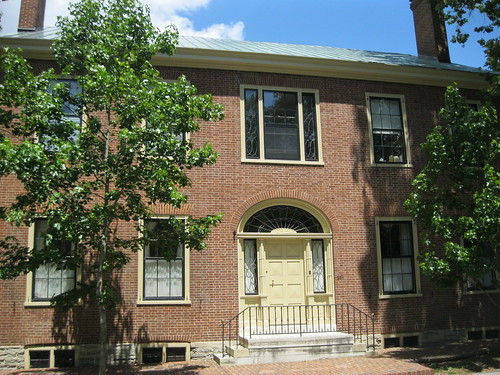 |
| Mount Hope – Lexington, Ky. |
Each of the residences in Gratz Park is beautiful and each has a terrific history. Mount Hope, a Federal two-story brick townhouse, was built in 1819 for General John McCalla, a hero of the War of 1812, who purchased the outlot on Mill Street from Thomas January. McCalla and his family would leave Lexington in 1832 for Washington, D.C. where McCalla had received a government appointment from President Polk.
General McCalla was an attorney who purchased and became the editor of The Kentucky Gazette (disputed to be the first newspaper west of the Alleghenies) in 1824. McCalla would also serve as the U.S. Marshal for Kentucky.
McCalla’s son, Dr. John Moore McCalla, Jr., was likely born at Mount Hope. He would go on to serve as the United States’ agent aboard the Star of the Union where he would ensure that the contract between the United States and the American Colonization Society was properly executed. The ACS sought to return slaves in America to Africa, the ultimate effect being the creation of Liberia. At hand was the return of 383 slaves who had been rescued aboard the slaveship Bogota.
Back to the house.
McCalla sold it in 1824, the same year he acquired The Kentucky Gazette, to Benjamin Gratz for whom Gratz Park was named. Mount Hope would remain in the hands of the Gratz family until 1984.
Benjamin Gratz was a successful hemp merchant whose family was famed for trading along the Philadelphia-Lexington-St. Louis Circuit. His vitae is impressive: “He was a part of nearly every beginning enterprise; was one of the incorporators of the City of Lexington, the hard surfaced Maysville Road, the Northern Bank of Kentucky, the Louisville & Ohio Railroad; and contributed materially to the location of the University of Kentucky in Lexington.”
Benjamin’s sister, Rebecca Gratz of Philadelphia, was a regular visitor to Mount Hope. She was a prominent educator and philanthropist who was the first female Jewish college student in the United States. It is believed that her charm caused Sir Walter Scott, upon introduction by mutual friend Washington Irving, to model his Ivanhoe character Rebecca of York after her. Hardly a spinster, Rebecca never married but allegedly turned down one suitor – a Gentile – because of her faith. She was known as the “foremost American Jewess of her day.”
 |
| Fluted window frames on Mt. Hope |
This five-bay Flemish bond brick has been said to be an excellent example of the “outstanding craftsmanship of early Kentucky brickmasons.” A notable feature, quite unusual for Lexington architecture, is the fluted window frames that have “carved corner blocks like interior woodwork” (pictured). In 1841, the architect John McMurtry designed an enlargement onto the rear of stately Mount Hope, which is also referred to as the Benjamin Gratz House.
More pictures of Mount Hope can be accessed here.
This post also appeared on KyForward.com on August 30, 2011.
Bluegrass Trust, “Gratz Park Spreads“
Lexington Cemetery History
National Register, “Gratz Park“
The Last Slave Ships, “Liberia History“
Sy Brody, “Jewish Heroes in America“
Wikipedia, “Ivanhoe“
